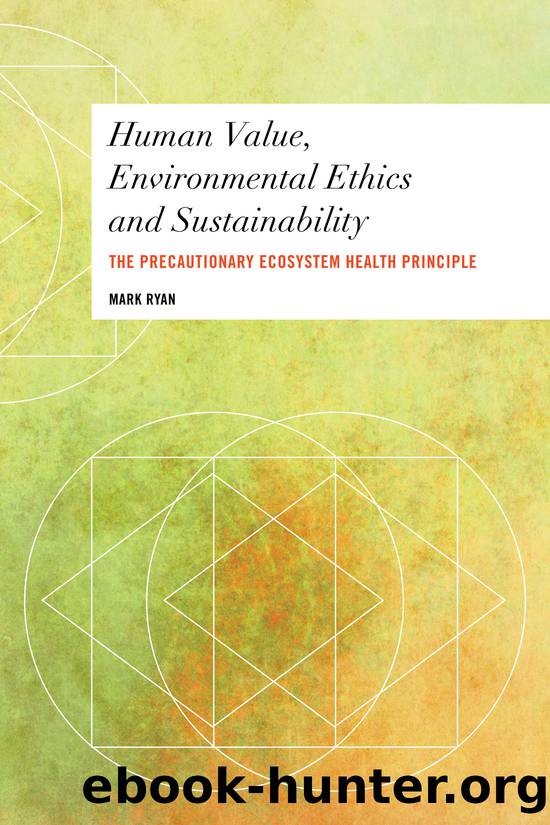Human Value, Environmental Ethics and Sustainability by Ryan Mark;

Author:Ryan, Mark;
Language: eng
Format: epub
Publisher: Rowman & Littlefield Unlimited Model
Chapter 6
The Precautionary Principle
The previous chapters gave us a clear analysis of EH, its objectives and why we should value it (ecosystem benefits, ecosystem services and cultural services). In this chapter, I will propose that when we combine it with the PP it gains practical strengths, while the PP gains stronger, scientific and valuative dimensions. I have already demonstrated the reasons for grounding EH and the PP on a weak anthropocentric framework, guided by contributory value, so it is important to develop upon this grounding in order to test the feasibility of the PEHP when it is philosophically scrutinised. I will argue that we should use the âPPâ to aid in the decision-making process, but from a weak anthropocentric instrumentalist position, rather than applying intrinsic value. However, firstly, it is important to identify what the PP is and where it originated from, before we investigate the valuative basis of the PP.
The PP originated in Germany in the late 1970s under the title ÂâVorsorgeprinzipâ, translated as the foresight principle â a principle that aims for anticipatory proactive policy in the face of uncertainty (Tickner 2002, p. 493). This term stems from the German term Vorsoge, which âcould be translated as taking care of the futureâ (Douma 2001, p. 111). The PP proposed that when there is a lack of scientific certainty about environmental outcomes, we should act cautiously. âIn order to protect the environment, the precautionary approach shall be widely applied by States, according to their capabilities. Where there are threats of serious or irreversible damage, lack of full scientific certainty shall not be used as a reason for postponing cost-effective measures to prevent environmental damageâ (Brown 1995, p. 67).
The early understanding of the PP supported precaution when activities threaten human health and the environment and placed the onus on those responsible for the action to prove that there was no threat of harm. When there is a lack of scientific certainty about harms to human health and the environment, then there is a responsibility to err on the precautious side until it can be established that there are no risks or that they are minimal/acceptable. The PP proposed that when there is a possibility of harm the responsibility to show that there is no risk, or that the risk is acceptable, is on those proposing the action(s). Alternatively, more succinctly put by Wingspread:
When an activity raises threats of harm to human health or the environment, precautionary measures should be taken even if some cause and effect relationships are not fully established scientifically. In this context the proponent of an activity, rather than the public, should bear the burden of proof. The process of applying the Precautionary Principle must be open, informed and democratic and must include potentially affected parties. It must also involve an examination of the full range of alternatives, including no action. (Wingspread 1998)
However, this is just one understanding of the PP, while other definitions imply that the threat of harm should be âseriousâ or âirreversibleâ. The Rio
Download
This site does not store any files on its server. We only index and link to content provided by other sites. Please contact the content providers to delete copyright contents if any and email us, we'll remove relevant links or contents immediately.
| Automotive | Engineering |
| Transportation |
Whiskies Galore by Ian Buxton(41720)
Introduction to Aircraft Design (Cambridge Aerospace Series) by John P. Fielding(33017)
Small Unmanned Fixed-wing Aircraft Design by Andrew J. Keane Andras Sobester James P. Scanlan & András Sóbester & James P. Scanlan(32685)
Craft Beer for the Homebrewer by Michael Agnew(18082)
Turbulence by E. J. Noyes(7895)
The Complete Stick Figure Physics Tutorials by Allen Sarah(7267)
Kaplan MCAT General Chemistry Review by Kaplan(6823)
The Thirst by Nesbo Jo(6763)
Bad Blood by John Carreyrou(6477)
Modelling of Convective Heat and Mass Transfer in Rotating Flows by Igor V. Shevchuk(6354)
Learning SQL by Alan Beaulieu(6160)
Weapons of Math Destruction by Cathy O'Neil(6085)
Man-made Catastrophes and Risk Information Concealment by Dmitry Chernov & Didier Sornette(5878)
Digital Minimalism by Cal Newport;(5588)
Life 3.0: Being Human in the Age of Artificial Intelligence by Tegmark Max(5405)
iGen by Jean M. Twenge(5326)
Secrets of Antigravity Propulsion: Tesla, UFOs, and Classified Aerospace Technology by Ph.D. Paul A. Laviolette(5238)
Design of Trajectory Optimization Approach for Space Maneuver Vehicle Skip Entry Problems by Runqi Chai & Al Savvaris & Antonios Tsourdos & Senchun Chai(4957)
Electronic Devices & Circuits by Jacob Millman & Christos C. Halkias(4866)
